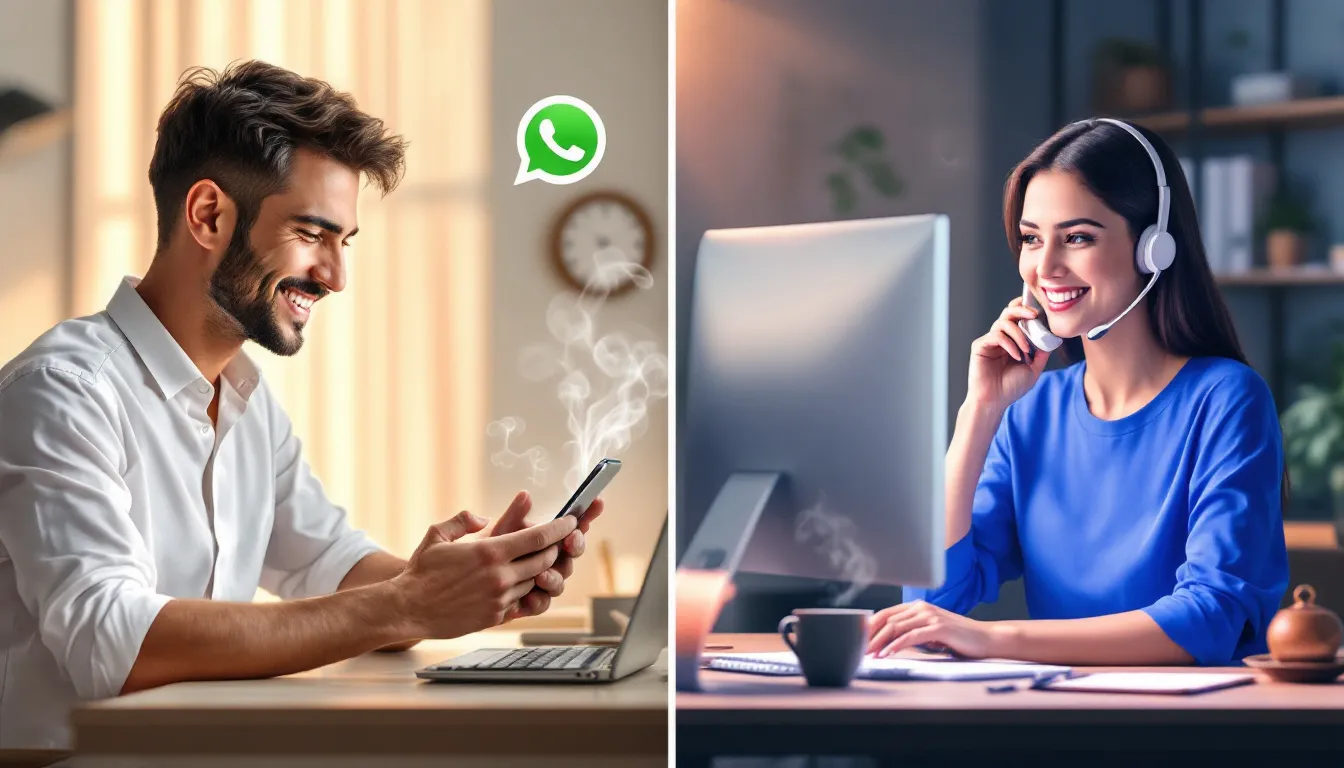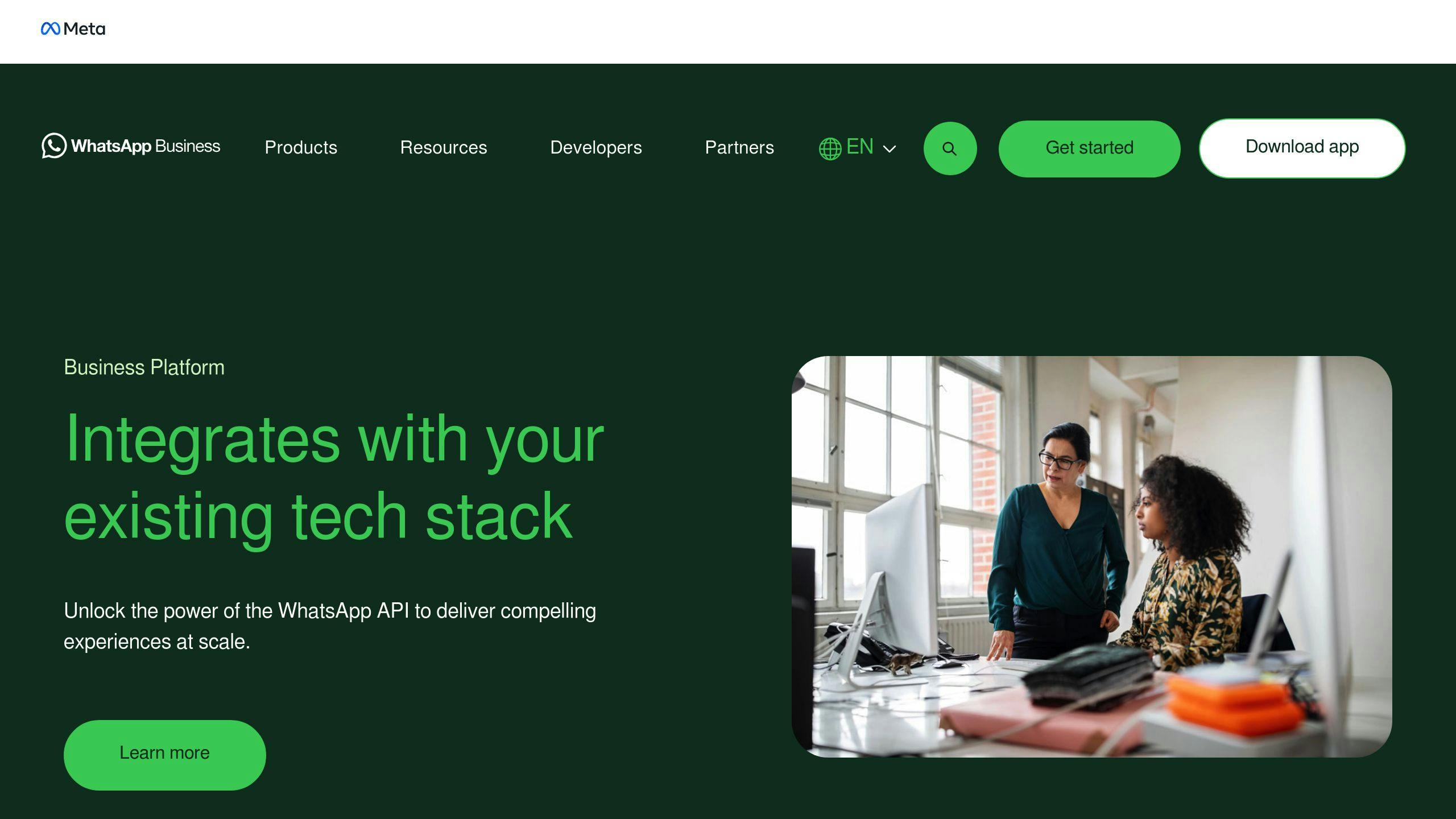WhatsApp vs Traditional Customer Service Channels: A Comparative Analysis for SMBs
Explore the benefits and drawbacks of WhatsApp versus traditional customer service channels for small and medium-sized businesses.

WhatsApp and traditional customer service channels each have pros and cons for small and medium-sized businesses (SMBs). Here's a quick breakdown:
WhatsApp:
- 2.5 billion users worldwide
- Fast response times (avg. 42 seconds)
- High engagement (98% open rate)
- Low cost (1,000 free service chats/month)
- Easy multimedia sharing
Traditional channels:
- Familiar to many customers
- No internet required for phone/in-person
- More personal for complex issues
- Preferred by some demographics (76% still like phone)
Quick Comparison:
| Feature | Traditional Channels | |
|---|---|---|
| Cost | Low | Often higher |
| Reach | Global | Location-limited |
| Speed | Near-instant | Can be slow |
| Engagement | High | Lower |
| Automation | Built-in tools | Varies |
Bottom line: Many SMBs find success using both. Consider your audience, resources, and long-term goals when choosing. Mix channels for best results.
Related video from YouTube
1. WhatsApp Business Platform Features

WhatsApp Business Platform packs a punch for small and medium-sized businesses (SMBs) looking to up their customer service game. Here's what you need to know:
Message Types and Limits
WhatsApp Business lets you chat with customers in different ways:
- Interactive messages with call-to-action buttons
- List messages with up to 10 options
- Reply buttons for quick, 3-option responses
The best part? You get 1,000 free service conversations each month. That's a lot of customer chats without breaking the bank.
Price Points
When it comes to pricing, WhatsApp keeps it simple:
| Conversation Type | Price Range |
|---|---|
| Business-initiated | $0.0083 - $0.1323 |
| User-initiated | $0.0025 - $0.0738 |
Pro tip: User-initiated chats are cheaper. Want to start conversations without paying? Use Click-to-WhatsApp Ads and chat for free within 72 hours.
System Setup and Tools
Getting started with WhatsApp Business is a breeze:
- Download the app
- Register your number
- Set up your business profile
The platform comes with handy tools:
- Catalogs to show off your products
- Collections to organize your offerings
- Quick Replies for common questions
- Away Messages for after-hours communication
- Labels to keep conversations organized
Daily Work Impact
WhatsApp Business can make your day-to-day operations smoother:
- Set up automated responses for FAQs
- Connect up to 10 devices to one account
- Track message performance with built-in analytics
Real businesses are seeing real results:
Bank Mandiri used WhatsApp Business to handle installment payment schedules and credit card verifications, making their financial services more efficient.
Modanisa expanded globally by offering customer support in five languages through WhatsApp Business.
With these features, WhatsApp Business isn't just another messaging app. It's a powerful tool for SMBs to create personal, efficient, and scalable customer interactions. Give it a try and see how it can transform your customer service.
sbb-itb-3424a64
2. Standard Customer Service Channels
Phone, email, and live chat are still go-to options for many SMBs. Here's a breakdown of these classic channels:
Message Types and Limits
Each channel has its own communication style:
| Channel | Message Type | Limits |
|---|---|---|
| Phone | Voice | One-on-one talks |
| Text, attachments | No character limit | |
| Live Chat | Quick text, links | Multiple chats at once |
Phone calls? Personal and immediate. Emails? Great for details. Live chat? Fast and info-packed.
Price Points
Costs vary:
- Phone: Often priciest. Needs dedicated staff and equipment.
- Email: More budget-friendly. Main cost? Staff time.
- Live Chat: Can be a bargain, especially with chatbots.
Take Blibli, an Indonesian online shop. They switched to chat support and boosted their response rate by 86%. Oh, and they saved over 631 hours in support time. Not too shabby!
System Setup and Tools
Setting up each channel is different:
1. Phone Support
Get a solid phone system, train staff in talking skills, and maybe record calls for quality checks.
2. Email Support
Pick a good email system, set up auto-replies, and create templates for common questions.
3. Live Chat
Choose chat software that works with your site, train agents in chat etiquette, and think about AI chatbots for round-the-clock coverage.
Daily Work Impact
Each channel affects your team differently:
Phone support lets you solve problems on the spot, but it's one customer at a time and can eat up time.
Email support gives you a record of conversations and time to research answers, but it might take longer to solve issues.
Live chat? Agents can juggle multiple chats, solve simple problems fast, and even use AI for basic stuff.
Ryan Baum, a customer service pro, says: "Customers love these one-to-one messaging channels for customer service because they're so quick and convenient." This is especially true for live chat - it's fast like phone calls but written like emails.
Here's the deal: offer a mix of channels that work for your customers and your business. While new platforms like WhatsApp are hot, many folks still like the classics. In fact, a 2019 study found 76% of customers still prefer to call when they need help.
Benefits and Drawbacks
WhatsApp and traditional customer service channels each have their pros and cons. Let's break it down:
| Aspect | Traditional Channels | |
|---|---|---|
| Cost | Free app, 1,000 free service chats/month | Often pricier, especially phone support |
| Reach | Global, 2.5 billion users | Limited by location |
| Response Time | Near-instant (avg. 42 seconds) | Can be slow (up to 8 days for email) |
| Engagement | 98% open rate | 21.5% average email open rate |
| Multimedia Sharing | Easy (images, videos, PDFs) | Can be tricky |
| Automation | Built-in tools like Quick Replies | Varies |
| Privacy | End-to-end encryption | Depends on channel |
| Scalability | Highly scalable | Can be tough without infrastructure |
WhatsApp: The Good and the Bad
WhatsApp's got some serious perks:
- It's cheap. Free app, 1,000 free service chats per month. Perfect for SMBs on a budget.
- It's everywhere. 2.5 billion users worldwide. That's a LOT of potential customers.
- People actually read your messages. 98% open rate. Compare that to email's measly 21.5%.
- It's fast. Average response time? 42 seconds. That's practically instant.
- Sharing stuff is a breeze. Images, videos, docs - you name it.
But it's not all sunshine and rainbows:
- Not much room for customization.
- No internet? No WhatsApp.
- Some folks are wary of the Facebook (Meta) connection.
- It's easy to overdo it and annoy customers.
Traditional Channels: Old School Cool or Old News?
The classics have their charm:
- Nothing beats a real conversation for that personal touch.
- Many businesses already have these systems in place.
- No internet? No problem for phone calls and face-to-face chats.
- Some customers (especially older folks) just prefer the old ways.
But they come with baggage:
- They can be expensive. Call centers and physical locations aren't cheap.
- Slow as molasses. Email responses can take up to 8 days. Yikes.
- Growing your support team? Get ready to shell out some serious cash.
- Limited hours. Unlike digital channels, you can't be open 24/7 without breaking the bank.
Real Talk
Bank Mandiri in Indonesia jumped on the WhatsApp train for handling payment schedules and credit card checks. Result? Their financial services got a major efficiency boost.
But don't count out the old ways just yet. A 2019 study found that 76% of customers still prefer to pick up the phone when they need help.
Here's the deal: It's not about choosing one or the other. Many SMBs find success by mixing it up. The trick is to figure out what works best for YOUR business, YOUR customers, and YOUR budget. Analyze, experiment, and find your sweet spot.
Conclusion
Let's break down the key differences between WhatsApp and traditional channels for SMBs:
| Aspect | Traditional Channels | |
|---|---|---|
| Cost | Low (free app, 1,000 free chats/month) | Often higher (especially phone support) |
| Reach | Global (2.7 billion users) | Limited by location |
| Response Time | Near-instant (avg. 42 seconds) | Can be slow (up to 8 days for email) |
| Engagement | High (98% open rate) | Lower (21.5% avg. email open rate) |
| Multimedia Sharing | Easy | Can be challenging |
| Automation | Built-in tools | Varies by platform |
| Privacy | End-to-end encryption | Depends on channel |
So, how do you choose between WhatsApp and traditional channels? Here's what to consider:
Know your audience If your customers love quick, tech-savvy communication, WhatsApp might be your best bet. Adidas nailed this with their "100% Unfair Predator" campaign on WhatsApp, connecting users with pro athletes for local games.
Look at your resources WhatsApp can be a budget-friendly option for small teams. Just ask Allo Innoware, an Indian D2C brand. They saw an 11X ROAS growth and a 9.76% conversion boost using WhatsApp Business.
Think long-term WhatsApp is great for quick chats, but don't forget about email. It still offers a $42 ROI for every $1 spent. That's nothing to sneeze at for long-term customer engagement.
Mix it up Why choose just one? Many SMBs find success by using WhatsApp for quick back-and-forths and email for more detailed messages. It's like having the best of both worlds.
Get smart with tech Check out platforms like Polser. They offer cool tools for managing WhatsApp customer service, including smart response suggestions and support for multiple languages.
